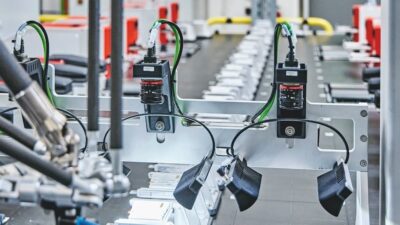Though the world's motion control markets remain splintered, global corporations are gobbling up many well-known brands, according to a recent study by Datamonitor, a London-based market analysis firm. The report, "Motion Control in the Leading Industrial Markets," identifies several forces that are altering motion control's 11 primary markets, which account for 90% of the $3.
Though the world’s motion control markets remain splintered, global corporations are gobbling up many well-known brands, according to a recent study by Datamonitor, a London-based market analysis firm. The report, “Motion Control in the Leading Industrial Markets,” identifies several forces that are altering motion control’s 11 primary markets, which account for 90% of the $3.6 billion global market.
Despite the motion control field’s traditional fragmentation, global automation firms and holding companies, such as Invensys and Danaher, exhibit a growing presence. Siemens leads with a 13% market share. However, the report states, “an astonishing number of smaller companies retain large shares of their national or regional markets.”
For small and large motion control firms alike, Datamonitor also found that OEMs remain the major route to market in the global motion control arena, though the end-user market is becoming more diverse. In addition, there are indications end-users are becoming more likely to implement motion control applications directly.
Growth by drive type
Datamonitor’s study also found that servo systems account for almost 70% of the motion control market by type of drive. Japan has the lowest relative market share for servo systems and the highest for stepper motor-based systems. In most markets, demand for servo motion systems has grown in line with, or slightly less than, overall market growth, except in Japan, where the market for servo motion systems has fallen over the last five years. Meanwhile, the U.K. has especially increased its use of variable-speed and universal drives in motion control.
The fastest growing type of controller packaging are PC-based and bus-based systems, which grew to 15% of the total market in 1999 from less than 10% in 1995. Overall, PLC-based systems are losing market share particularly to bus-based motion control systems.
Merging fragments
Previously characterized by splits from existing firms, often to fill niche markets, the motion control field’s recent consolidation has meant that small companies entering the market are now more likely to be experts in new automation technology, rather than ex-employees of motion control specialists. These companies are changing the technology base of the industry and are becoming targets for larger firms.
Among the six firms with relatively high shares of the global market, Datamonitor reports that Rockwell Automation, Mitsubishi Electric, and Siemens vie for global leadership in motion control. Mitsubishi was world market leader, but the slow Japanese market has allowed both Siemens and Rockwell to overtake it. The report adds that Rockwell has a dominant position in the U.S., but trails in Germany and Japan. Siemens is currently global leader, but just barely.
For more information, visit www.datamonitor.com or www.controleng.com/freeinfo .
Motors with built-in drives increasing
Though initial demand for motors with built-in drives was slow in the past few years, the combined North American and European markets will likely grow to exceed $500 million by 2005, according a recent report by Intex Management Services (IMS, Wellingborough, U.K.).
The report, “European and North American Markets for Motors with a Built-In Drive,” projects that European suppliers will increase quickly over the next several years. The motors referenced in this report are standard ac induction motors providing speed control, and are distinct from step and servo motors used for position and motion.
There are already more than 20 motor/drive suppliers, such as ABB Motors, Brook Hansen, Danfoss, Grundfos, Leroy Somer, Lenze, SEW Eurodrive, and Siemens. The most likely new entrants will be European motor manufacturers using compact drive modules from drive firms. For example, Bonfiglioli, Flender, Sumitomo, and others have already formed integrated motor/drive packages by integrating Siemens’ Combimaster module into their motor lines, according to IMS.
The report adds that standard and geared motors with built-in drives are being used in applications where usually either a fixed-speed motor with no external speed control or an alternative drive solution, such as a standalone ac drive, would have been used. So far, most motors with built-in drives have been used in fan and pump applications, though IMS expects material handling to be a high-growth area in the future. This is because motors with built-in drives can reduce cabling costs in conveyor applications.
For more information, visit or



